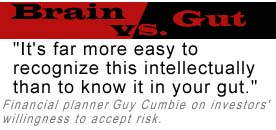|
Common investor mistakes
|
 |
August 31, 1998: 10:42 p.m. ET
For many stock pickers, investing is a matter of trial and error, error, error
|
NEW YORK (CNNfn) - You'd think investors would learn from their mistakes. Instead, they more often choose to pursue a repetitive pattern of trial and error and error and error.
Hints, tips, hunches and urges all work together, laying traps which capture investors. But unfortunately, like a species that learns neither to fight nor flee, the unwary investor is doomed to fail.
Many investors endanger their chances almost from the outset by neglecting to have a financial plan in place before they start throwing their money at stocks.
Instead of deciding what their goals are, investors often feel the most important thing is to get their money into the market as soon as possible, a mindset that immediately puts their goals at risk.
Investor goals act as constraints, but also guides, to how you will invest. If you have a long-term goal such as retirement in 30 years, growth stocks may be something you want to pursue.
However, a shorter-term goal such as college for your grade-school aged children, would change your investment choices. Setting off without a map for these goals then becomes the first mistake that could lead to others.
Investor myopia
Investors look at the market with myopic vision and even if they say they want to look at it more clearly, they often don't, according to Guy Cumbie, a board member at the Institute for Certified Financial Planners.
Cumbie, a certified financial planner himself in Fort Worth Texas, says his first order of business with clients is to explain the ups and downs of the markets and coach them not to expect a steady, straight line of investment returns.
This warning, said Cumbie, is often met with agreeing nods of the heads from investors but reality is much different.
"It's far more easy to recognize this intellectually than to know it in your gut," said Cumbie, who said there is often a need for "hand holding" with the client when this acceptance of market volatility is put to the test.
Almost every investment comes with a warning that previous performance doesn't guarantee future returns. This, too, is generally ignored.
Investors make the mistake of believing too fervently in hot past performance by a stock or a fund, said Cumbie. Urging them along with this is a skewed vision, known as "periodicity," of what the actual investing climate is like.
Investment returns can be subtly (and not so subtly) transformed by periodicity. Depending on what calendar period of time you slice out and look at, an investment can either look like a tremendous winner or a sure loser.
For instance, a mutual fund over the past 3 years might have produced great returns. However, if you look at it over 10 years, it might have had much weaker returns.
Since these time slices are arbitrary, investors are better off taking a long view, "The focus has to remain on the fact that there's a long-term upward march that you better have faith in or you're better off staying out of equities," said Cumbie.
"If you go in expecting 10 percent annual returns and straight lines, it's not going to work."
Mental shortcuts
Investors who look at past returns and extrapolate them into the future are making a common investor mistake Gergory Lintner calls taking "mental shortcuts."
Lintner, a chartered financial analyst at Yanni-Bilkey Investment Consulting in Pittsburgh, Pa., said investors are not inquisitive enough about their investments, choosing instead to rely on superficial impressions, or mental shortcuts, which require less work.
"The intelligent investor is going to look behind what has driven a stock or fund higher and whether that's likely to continue," said Lintner.
Oftentimes, he explained, a fund's strong performance can be attributed not to deft stock-picking by its manager, but instead to its overall investment style being in favor.
However, fund styles can go out of favor just as quickly, leaving investors with a fund that is yesterday's news. "It's just not predictable," he said.

Investors make big misjudgments in the area of risk, said Lintner. He explained they tend to judge their own risk tolerance based on what's happened recently. If they've had five years of good investing in a bull market, they'll say they have a high risk tolerance. When put to the test in a bear market, they invariably feel less strongly about stocks.
Common sense is often also jettisoned when the inevitable bear market hits. Lintner said investors often use a counterintuitive approach to buying stocks which flies in the face of normal purchasing behavior.
"At any other time, whether you're shopping for food, clothing or furniture, you're excited when things go on sale but when stock prices go down, people behave in the opposite manner," he said.
"They should use the low prices to accumulate shares."
Blaming bad luck
Even investors who might wish to learn from their mistakes are often prevented from doing so by their own imperfect perceptions of themselves, academic research suggests.
"They take too much credit for their success and blame bad luck for their failures," according to Simon Gervais, assistant professor of finance at the Wharton School of the University of Pennsylvania.
Gervais' study focused on the behavior of investors and he found people who make a quick killing in the stock market think they have somehow found the key to financial success and become overconfident about their ability to play the market.
Investor overconfidence is created by the initial success but the process isn't self-perpetuating, said Gervais.
"Once a trader is overconfident --and wealthy -- he will tend to make bad decisions (based on that overconfidence) and will start to lose money, until he finally comes to assess his own ability correctly."
Financial experts say you can avoid some of that "bad luck" by following some of the basic, boring tenets you adhere to in other parts of your life.
Most importantly, don't jump into an investment based on a tip by a friend or relative. Instead, put in the time to research an investment and understand its risks and rewards. It's better to spend some time before you spend your money.
The process doesn't stop once you've bought the stock either. You'll want to keep on top of your investment portfolio and be informed about any company developments which could affect your stocks.
These guidelines don't necessarily mean you'll need to turn into a bloodless investor who can't set off toward a hot sector when the urge moves you. Just do it responsibly.
"Investors typically want to carve out a small amount for uncompensated risk," said financial planner Cumbie. "You just need to know what you're doing and do it with the cognizance that you're taking a risk." 
-- by staff writer Randall J. Schultz
|
|
|
|
|
 |

|

